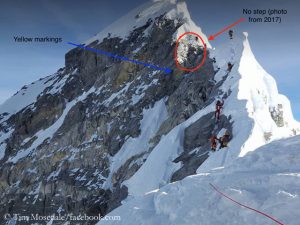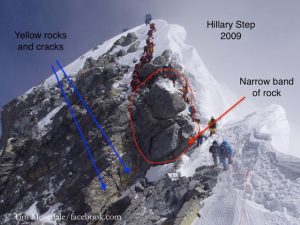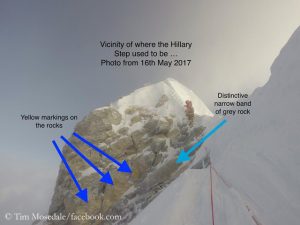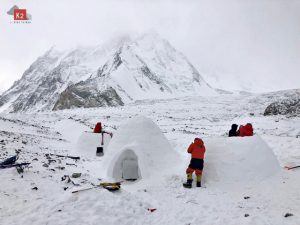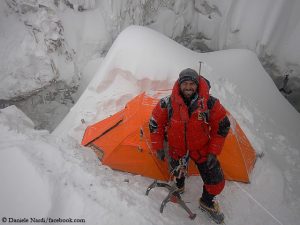Once upon a time … the Hillary Step
The big boulder is gone. This is for sure. Tim Mosedale, a six-time Everest summiter from the UK, has added some pictures to Facebook to support his statement that the Hillary Step, the striking twelve-meter-high rock at 8,790 meters, no longer exists in its previous form. Tim’s pictures show: Where once a mighty boulder represented the last serious challenge before the summit, now only a few chunks are lying around. The British expedition leader had already claimed this in mid-May after his successful summit attempt: “It’s official. The Hillary Step is no more.”
Government speaks of misconception
Mosedale had to accept some criticism, especially from Nepal, where he was accused of spreading “fake news”. The Nepali government made even an official statement. They had asked the “Icefall Doctors”, the highly specialized Sherpas on Everest, wrote the Ministry of Tourism in a press release: “The report furnished by the Icefall Doctors confirms that the Hillary Step is still intact and is covered with snow. The misconception may have appeared as a new route to the summit is constructed which is some five meters right to the original route.”
The last-mentioned was right, says Mosedale, “but it was to the right because the Hillary Step wasn’t there and we ascended a snow ridge instead.” The Briton receives backing from other climbers who were on the summit this spring, such as the US expedition leader Garrett Madison. “It’s pretty obvious that the boulder fell off and has been replaced by snow, Madison told the magazine “Outside”. “You can see some of the rocks below it that were there before, but the gigantic boulder is missing now.”
Result of the 2015 earthquake?
This made the ascent easier during this spring’s season, with a lot of snow in the summit area. The consequences of the change in terrain during dry years with little snow, in which there is no broad snow ridge, remain to be seen.
Already in 2016, climbers had reported that the Hillary Step looked different compared with the time before the devastating earthquake in Nepal two years ago. It is quite possible that the big boulder has become loose and fallen down during the quake. Summit aspirants staying in the Western Cwm on 25 April 2015 had watched stonefall from Everest and Lhotse.
Last key section before the summit
The Hillary Step is more than just a piece of mountain, it is a myth. Climbing experts classify the rock only somewhere between the first and second degree of difficulty according to the scale of the International Climbing and Mountaineering Federation (UIAA). But at this extreme altitude, where oxygen is pressed into the lungs with only one-third of the pressure compared to sea level, even this climbing, which might be laughed at in the Alps, becomes a real challenge. It was not without reason that over years traffic jams formed on Hillary Step, because many clients of commercial expeditions were just overstrained. On the first ascent in 1953, the New Zealander Edmund Hillary had taken heart and had climbed up through a thin crack between rock and ice. “It was then for the first time that I knew that we were going to get to the top, “ the Everest pioneer once said about the last key section that had been named after him. The New Zealander died in 2008 aged 88.
Wrath of the gods
Mountains are exposed to seismic activities as well as the climate and thus can change. Rockfall occurs all over the world. Thus Mount Cook, the highest mountain of New Zealand, lost considerably height in 1991, when rock and ice broke down from the summit. So why shouldn’t it happen on Mount Everest? The Sherpas call the highest of all mountains Chomolungma, “Goddess Mother of the World”. Natural events such as rock fall or avalanches are regarded in their faith as a sign that people have incurred the wrath of the gods. Perhaps that explains why many people in Nepal don’t want to accept that the Hillary Step does not look like it was before.



